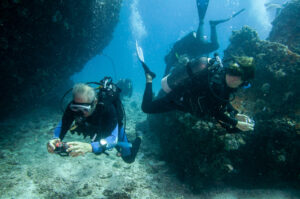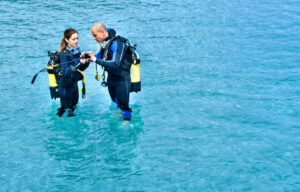What is Equalization when Scuba Diving?
Equalization is a vital process for scuba divers, referring to the act of balancing the pressure of a gas-filled space with the surrounding or ambient pressure. This technique is essential in counterbalancing the increase in water pressure as divers descend and ascend, ensuring a safe and comfortable diving experience.
Understanding Pressure in Diving
As a diver descends, the water pressure around them increases. For every 10 meters (33 feet) of water depth, the pressure increases by approximately one atmosphere. This change in pressure affects any air-filled space in the diver’s body or equipment, potentially causing discomfort or injury, collectively referred to as barotrauma.
Types of Equalization
Equalization procedures can be applied to various gas-filled spaces within a diver’s body and equipment.
Ear Equalization: The most commonly known equalization procedure is for the ears, specifically the middle ear. The Eustachian tubes connect the middle ear to the back of the throat, allowing divers to equalize pressure by forcing air up these tubes, usually by swallowing, yawning, or using specialized techniques like the Valsalva or Frenzel maneuvers.
Mask Equalization: The air space in a diver’s mask must also be equalized. This is done by exhaling through the nose into the mask, which increases the air pressure within the mask to match the surrounding water pressure.
Suit and Buoyancy Compensator Device (BCD) Equalization: Dry suits and BCDs have air spaces that need equalization. For dry suits, air is added via an inflator valve, while for BCDs, divers use the inflator button to add air as they descend and release air as they ascend.
Barotrauma and Equalization
The failure to correctly equalize pressure can result in barotrauma, a physical injury caused by a pressure difference between a gas space inside, or in contact with the body, and the surrounding gas or fluid pressure. Barotrauma can occur in different parts of the body:
Ear Barotrauma: Unequalized pressure can lead to ear barotrauma, causing pain, hearing loss, dizziness, or in severe cases, a ruptured eardrum.
Mask Barotrauma or Mask Squeeze: If a diver fails to equalize their mask, the increased pressure can cause facial barotrauma or “mask squeeze,” resulting in petechiae (small, red or purple spots), bloodshot eyes, or in severe cases, damage to the eyes.
Suit or BCD Squeeze: Failure to equalize a dry suit or BCD can lead to “squeeze,” where the suit or BCD is forced against the body, causing discomfort or bruising.
Pulmonary Barotrauma: This is a severe condition that can occur if a diver ascends too quickly without exhaling, causing the air in the lungs to expand rapidly and possibly rupture lung tissue, leading to an air embolism.
Equalization Techniques
Effective equalization requires specific techniques and practices:
Pre-dive: Equalization starts even before entering the water. Divers must ensure they are in good health, as a blocked nose or congested ears can hinder effective equalization.
During descent: Divers should descend feet first, which facilitates better air flow up the Eustachian tubes. Equalization should begin at the surface and be performed frequently and gently during the descent.
During ascent: The most crucial rule during ascent is never to hold one’s breath. This allows the expanding air in the lungs to escape and prevents pulmonary barotrauma.
Equalization Tools and Aids
For divers who struggle with equalization, certain tools and aids can assist. Decongestants can clear the nasal passages and Eustachian tubes, but should be used with caution as rebound congestion can occur. Earplugs designed for diving can slow the rate of pressure change in the outer ear, allowing more time for equalization. Special devices that exercise the Eustachian tubes can also be used before diving to improve their function.
Equalization and Diver Training
Proper training is essential for safe and efficient equalization. Novice divers are taught the basics of equalization, starting with understanding the principles of pressure changes under water and the necessity of equalization. They then learn the techniques for equalizing ears and masks, and how to use their equipment to equalize other air spaces.
More advanced training builds on these skills, teaching divers how to deal with equalization issues that may arise during a dive. This includes learning how to recognize the early signs of barotrauma and what to do if equalization isn’t working. Some divers may need to seek additional specialized training or medical advice if they consistently have trouble with equalization.
Equalization Challenges and Precautions
Despite its seeming simplicity, equalization can pose challenges. Some divers have narrow or less flexible Eustachian tubes, making equalization difficult. Chronic sinus or allergy problems can also interfere with equalization. In such cases, divers should seek medical advice before diving.
Equalization must be done gently to avoid injury. Forceful equalization can damage the delicate tissues in the ears and sinuses. If equalization isn’t possible, the dive should be aborted to prevent barotrauma.
The Future of Equalization in Diving
As our understanding of human physiology and diving medicine continues to expand, so too will our methods for equalization. Current research is exploring new techniques, tools, and training methods to make equalization easier and more efficient.
Key Takeaways
Equalization is a fundamental skill in scuba diving, essential for both safety and comfort. By understanding the principles behind it and learning the proper techniques, divers can prevent barotrauma and have a more enjoyable experience underwater. Whether a beginner or an experienced diver, continuous learning and practice of equalization techniques are critical for every underwater adventure.

















